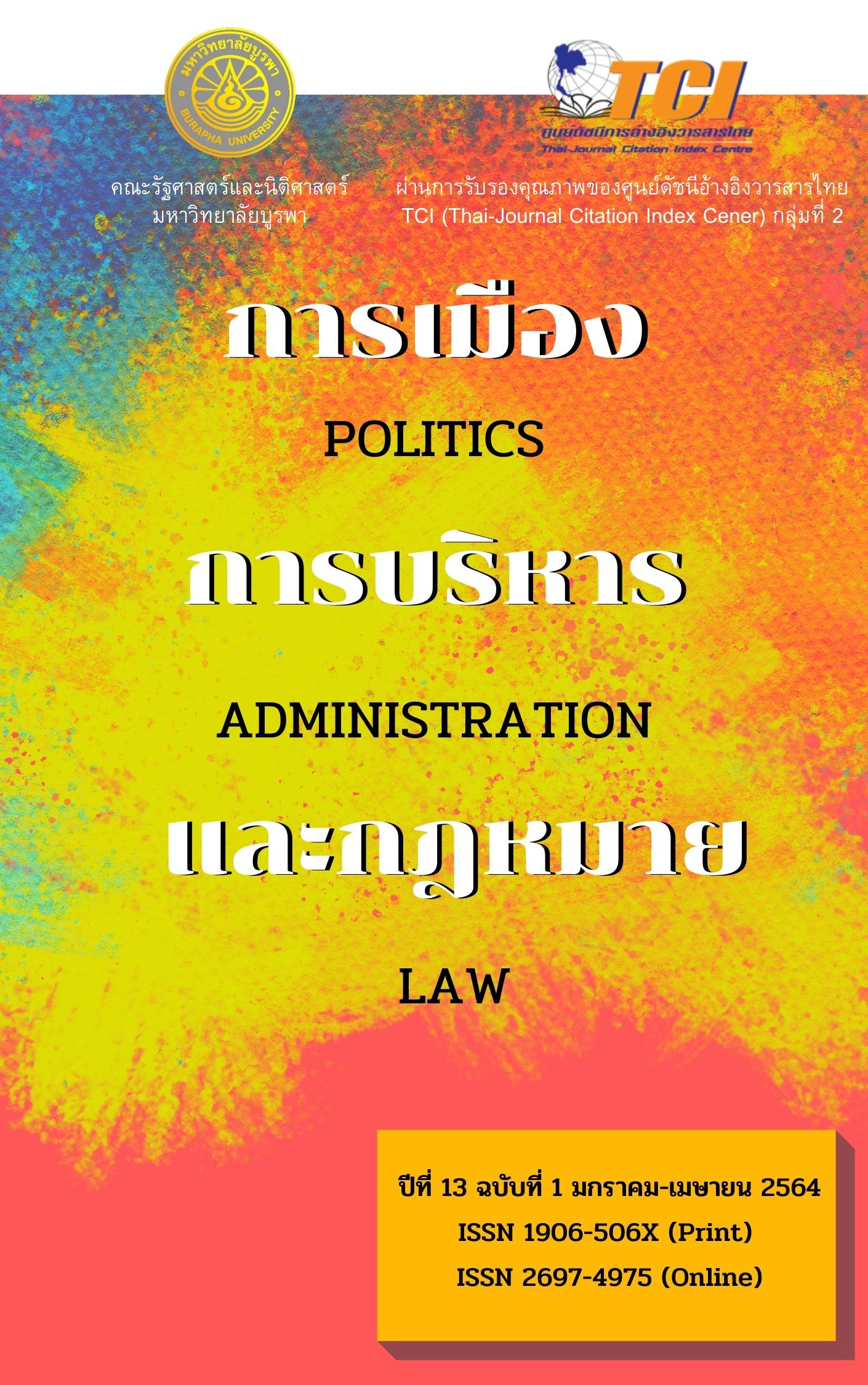รูปแบบการสร้างความผูกพันของพนักงานที่มีต่อ บริษัท ธนารักษ์ พัฒนาสินทรัพย์ จำกัด
คำสำคัญ:
ความพึงพอใจ, ความผูกพันของพนักงานบทคัดย่อ
การวิจัยครั้งนี้มีวัตถุประสงค์เพื่อ 1) ศึกษาปัจจัยความผูกพัน และรูปแบบการสร้างความผูกพันของพนักงาน 2) ศึกษาความพึงพอใจและความผูกพันของพนักงานบริษัท ธนารักษ์ พัฒนาสินทรัพย์ จำกัด และ 3) จัดทำรูปแบบการสร้างความผูกพันของพนักงานที่มีต่อบริษัท ธนารักษ์ พัฒนาสินทรัพย์ จำกัด โดยศึกษาการวิจัยเชิงปริมาณ ใช้แบบสอบถาม และการวิจัยเชิงคุณภาพ ใช้การสนทนากลุ่ม ผลการวิจัยพบว่า 1) ความผูกพันของพนักงานมีความสำคัญต่อองค์กรอย่างมาก โดยความผูกพันจะส่งผลให้พนักงานมีความรู้สึกต่อองค์กรในทางบวก ซึ่งมีความผูกพันที่มีต่องาน เป้าหมาย และค่านิยมขององค์กร และผลการสำรวจความผูกพันของพนักงานที่มีต่อบริษัท ธนารักษ์ พัฒนาสินทรัพย์ จำกัด 3 ปีที่ผ่านมา พนักงานมีความพึงพอใจและความผูกพันแนวโน้มสูงขึ้น มีค่าเฉลี่ย 3.60 – 4.60 ซึ่งอยู่ในระดับมาก ทำให้ผู้วิจัยต้องการศึกษารูปแบบและแนวทางการสร้างความผูกพันของพนักงาน เพื่อนำรูปแบบฯ มาพัฒนาการบริหารบุคลากรภายในองค์กรให้มีศักยภาพในการทำงาน และมีความผูกพันต่อองค์กร พร้อมที่จะเดินหน้าพัฒนาองค์กรอย่างยั่งยืน 2) ผลการสำรวจความพึงพอใจและความผูกพันของพนักงานบริษัท ธนารักษ์ พัฒนาสินทรัพย์ จำกัด พบว่า ความผูกพันต่อองค์กร อยู่ในระดับมาก มีค่าเฉลี่ยเท่ากับ 4.39 และความพึงพอใจต่อองค์กรของพนักงาน อยู่ในระดับมากที่สุด มีค่าเฉลี่ยเท่ากับ 4.55 3) รูปแบบการสร้างความผูกพันของพนักงาน ประกอบด้วย การสรรหาพนักงาน การดูแลพนักงาน และการเก็บรักษาพนักงาน เน้นการสร้างวัฒนธรรมองค์กร การสร้างคนเก่งและมีความสามารถ การสร้างการมีส่วนร่วม การสร้างการทำงานเป็นทีม และการสร้างขวัญและกำลังใจ มีส่วนร่วมในการทำโครงการ/ กิจกรรม ซึ่งทำให้มีผลต่อความพึงพอใจและความผูกพันของพนักงานที่มีต่อองค์กร
เอกสารอ้างอิง
จิตติภา ขาวอ่อน. (2547). ความพึงพอใจในการปฏิบัติงานของข้าราชการสำนักงานปลัดกระทรวงกระทรวงศึกษาธิการ. วิทยานิพนธ์ครุศาสตรมหาบัณฑิต, สาขาการบริหารการศึกษา, บัณฑิต วิทยาลัย, มหาวิทยาลัยราชภัฏเทพสตรี.
เจริญจิตร เศวตวาณิชกุล. (2559). รูปแบบการสร้างความผูกพันของพนักงานที่มีต่อโรงงานประกอบรถยนต์ในประเทศไทย. วิทยานิพนธ์บริหารธุรกิจดุษฎีบัณฑิต, คณะบริหารธุรกิจ, มหาวิทยาลัยธุรกิจบัณฑิตย์.
เดชา เดชะวัฒนะไพศาล. (2559). การจัดการทรัพยากรบุคคลพื้นฐานแนวคิดเพื่อการปฏิบัติ. กรุงเทพฯ: โรงพิมพ์แห่งจุฬาลงกรณ์มหาวิทยาลัย.
ประดิษฐพงษ์ สร้อยเพชร. (2557). ความผูกพันต่อองค์กรของพนักงานบริษัทโทรคมนาคมและเทคโนโลยีสารสนเทศแห่งหนึ่งส่วนงานวิศวกรรมที่ทำงานในเขตกรุงเทพมหานคร. การค้นคว้าอิสระ บริหารธุรกิจมหาบัณฑิต, มหาวิทยาลัยเนชั่น.
ปรียาพร วงศ์อนุตรโรจน์. (2535). จิตวิทยาบริหารบุคคล. กรุงเทพฯ: สหมิตรออเซท.
พรทิพย์ ไชยฤกษ์. (2555). ความผูกพันต่อองค์กรและพฤติกรรมเชิงสร้างสรรค์ของบุคลากรสถาบันวิจัยแสงซินโครตรอน (องค์การมหาชน). นครราชสีมา: คลังปัญญา มหาวิทยาลัยเทคโนโลยีสุรนารี.
พิชิต เทพวรรณ์. (2554). การจัดการทรัพยากรมนุษย์เชิงกลยุทธ์. กรุงเทพฯ: ซีเอ็ดยูเคชั่น.
พิรินทร์ชา สมานสินธุ์. (2554). ปัจจัยที่มีอิทธิพลต่อการสร้างความผูกพันของพนักงาน ศึกษาเฉพาะกรณีบริษัท เบสท์เพอฟอร์แมนซ์เอ็นจิเนียริ่ง จำกัด. บริหารธุรกิจมหาบัณฑิต, สาขาวิชาการจัดการ ทรัพยากรมนุษย์, บัณฑิตวิทยาลัย, มหาวิทยาลัยหอการค้าไทย.
ยงยุทธ เกษสาคร. (2547). ภาวะผู้นำและการทำงานเป็นทีม. นนทบุรี: ปัณณัชต์.
ศุภชัย เหมือนโพธิ์ นนทวัฒน์ สุขผล และณัฐพร วิรุฬหการุญ. (2561). ความพึงพอใจและความผูกพันต่อองค์กรของพนักงาน กรณีศึกษา บริษัท ธนารักษ์ พัฒนาสินทรัพย์ จำกัด. วารสารรังสิต บัณฑิตศึกษาในกลุ่มธุรกิจและสังคมศาสตร์, 4(2), 104-120.
ศุภชัย เหมือนโพธิ์ นนทวัฒน์ สุขผล และทาริกา สระทองคำ. (2561). ความพึงพอใจและความผูกพันต่อองค์กร ของพนักงาน บริษัท ธนารักษ์พัฒนาสินทรัพย์ จำกัด. วารสารศิลปากรศึกษาวิจัย, 10(2), 95-109.
สมยศ นาวีการ. (2540). การบริหารและพฤติกรรมองค์การ เรื่องการจูงใจ: จากแนวความคิดไปสู่การประยุกต์ใช้. กรุงเทพฯ: สำนักพิมพ์บรรณกิจ.
สมศักดิ์ ปิดตานัง. (2555). ความผูกพันของ องค์กรที่มีอิทธิพลต่อการปฏิบัติงานร่วมกัน. การค้นคว้าอิสระบริหารธุรกิจบัณฑิต, สาขาวิชาวิศวกรรมธุรกิจ, มหาวิทยาลัยเทคโนโลยีราชมงคลธัญบุรี.
สุธานิธิ์ นุกูลอึ้งอารี. (2555). การศึกษาความพึงพอใจในงานของพนักงานบริษัท การบินไทย จำกัด (มหาชน) กรณีพนักงานบริษัทการบินไทยฯ สำนักงานใหญ่. การค้นคว้าด้วยตนเอง หลักสูตรบริหารธุรกิจมหาบัณฑิต, สาขาวิชาการจัดการทรัพยากรมนุษย์, บัณฑิตวิทยาลัย, มหาวิทยาลัยหอการค้าไทย.
สุรเชษฐ์ ผการัตน์สกุล. (2552). ความพึงพอใจในการปฏิบัติงานของพนักงานธนาคารกรุงเทพ จำกัด (มหาชน) ภาคนครหลวง 2. ภาคนิพนธ์บริหารธุรกิจมหาบัณฑิต, สาขาการจัดการทั่วไป, บัณฑิต วิทยาลัย, มหาวิทยาลัยราชภัฎธนบุรี.
Allen, N. J., & Meyer, J. P. (1990). The Measurement and Antecedents of Affective, Continuance and Normative to the Organizations Commitment to the Organizations. Journal of Occupational Psychology, 63(1), 1-18.
Hewitt Associates. (2004). Impact of Engaged Employees on Business Outcomes; Ongoing Employee Engagement Research. Retrieved October 2, 2018, from http://www.aon.com/default.jsp
Kleysen R. F., & Street, C. T. (2001). Toward a multi-dimensional measure of individual Innovative Behavior. Journal of Intellectual Capital, 2(3), 284-296.
Krejcie, R. V., & Morgan, D. W. (1970). Determining Sample Size for Research Activities. Educational and Psychological Measurement. 30, 607–610.
Lockwood, N. R. (2007). Leveraging employee engagement for competitive advantage: HR’s strategic role. HR Magazine, 52, 1-11.
Roger, G. R. (1959). Creativity. Hormondsworth: Penguin Book.
Strauss, G., & Sayles, L. R. (1980). Personnel: The Human Problems of Management. New Jersey: Prentice-Hall.
ดาวน์โหลด
เผยแพร่แล้ว
ฉบับ
ประเภทบทความ
สัญญาอนุญาต

อนุญาตภายใต้เงื่อนไข Creative Commons Attribution-NonCommercial-NoDerivatives 4.0 International License.






